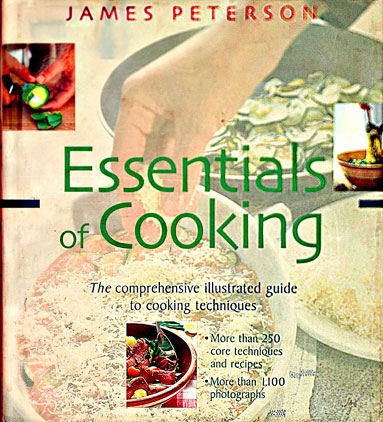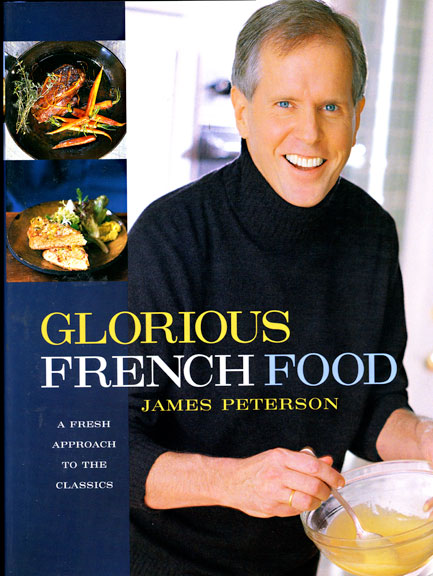I have a close friend who lives in Paris. She, like I, trained as a chef and knows how to cook. She’s raising her 16-year old son single handedly while she translates 6 days a week at Le Cordon Bleu where she works as many as 12 hours a day. Even though she comes home exhausted, she always provides a proper meal for her son: a proper French meal, with courses and a variety of dishes. We speak often on the phone–just about everyday–when it’s about 5 pm my time and 11 pm her time. I’m sipping on my first cocktail and she’s making or eating dinner. The process, for me, is slow torture. She starts out describing the products that are about to be cooked–things that we can’t find here like wild game, the best butter in the world, or fresh goose foie gras, and by the time she’s starting to cook, my stomach is growling.
Last night, she made blanquette de veau. A veal blanquette is somewhat like a veal stew except for a couple of things. First, the meat is poached rather than braised. The poaching liquid is then finished with a flour roux. Egg yolks are added to the thickened poaching liquid and the mixture slowly stirred until the egg yolks gently thicken it and turn it silky. Cream is then added. In traditional versions, mushrooms and pearl onions are included to go along with the meat. The blanquette is served with rice.
A blanquette is a pretty straightforward affair, but there are certain caveats and tips. In France, they call for the tendron which is a part of the breast and is, in fact, the least expensive cut of veal you can buy. In this country, I buy either a whole or half breast of veal, trim off the fat and gristle, and separate the meat from the bones. I then use the bones, along with some aromatic vegetables, to make a basic veal broth in which to poach the meat. This is important: blanch both the meat and the bones (not together) by putting them in a pot of cold water. Bring the water to a simmer, drain the meat or bones, and rinse with cold water. If you don’t follow through with this blanching process, the poaching liquid will be grey and taste like soap. Once the bones are blanched, make the broth. When the meat has been blanched, it is ready to be poached–usually for about 40 minutes–in the bone liquid.
Once the meat has been poached, you’ll be left with a very flavorful poaching liquid. This liquid can be reduced to intensify its flavor but, more typically, it is simply thickened with roux to give it the right consistency. Once the roux has been incorporated–or rather, the poaching liquid whisked into the roux–the liquid can be combined with egg yolks (traditionally about 8 per quart of liquid) and gently cooked over the stove (while stirring constantly) until the liquid takes on a silky consistency. Rhona then finishes this concoction with organic crème fraîche, cream of a quality we can’t get in this country. For some reason French cream tastes better than American cream, even American cream that’s been cultured into crème fraîche. They typically eat near midnight.



Thank you for this inspirational post. I tried making blanquette de veau for the first time last week and my family thought it was a success. The recipes in Cooking and Glorious French Food were my reference. I used some boneless “Veal Roast” from my local store and blanched it for five minutes then poached it for an hour. I didn’t have any white mushrooms (not a fan of them anyway) so I made a first attempt at tourneing some carrots, turnips and parsnips and added some pearl onions, which have been waiting for the chance to be used in something for weeks. I made two batches over two weeknights and finished one batch with heavy cream and another with roux. I also added defrosted baby peas to one batch which provided a great color contrast. I think the sauces came out OK without the egg yolks. My daughter really liked the sweetness that carrots and parsnips added to the sauce.
Hi Dimitry,
Sorry for taking so long to respond to your comment. I’m so glad you made the blanquette and liked it. You’re right; the egg yolks are really superfluous unless you’re committed to making a classic version. Good luck in future projects.
Jim
Hi Dimitry,
I’m glad your “blanquette de beau” was a success. You did exactly what I encourage my readers to do–improvise.
Dear Jim, this might not be the right place to post, but I just got your new book “Done” today. It looks great, and reads even better.
Ivar
I have been looking for a cookbook for the past week on Amazon to learn to make all the sweet dough comfort rolls that were once displayed in Bakery cases across america. Rolls like Cinnamon Rolls,butterfly rolls, pecan rolls,long johns, twists, chain twists, bismarks, bear claws, elephant ears, crullers, snails, raisin buns, hot cross buns and criss cross coffee cakes etc. These are just the ones I remembered from my upper midwest bakery I visited in my youth.. To my dismay and disappointment their are cookbooks with some in them but there numbers are shadowed by tarts, pies, cakes and artisan bread. Then their are those listed cookbooks to attact the artisan pastry home baker but not simple, good tasting sweet rolls with varible fillings and icings. the variety of sweet rolls varied by their ethnic providers. Bakers that were Polish, Swedish, German, Italian etc.I have tried all combination of word searches and viewed pages and checked indexes and found nothing specific to Bakery Sweet dough Recipes. Oh I found Judith Fertigs cookbook “I love cinnamon rolls” and Grandma Rose baking book from the past and even that one was crowded and limited by other bakery goods.
I would love to find one full source devoted to American ethnic Sweet dough baking across America. These might not interest a artisinal baker but it would interest home bakers to recreate what they remember enjoying from their past as youth. Either making for themselves, for friends or gifts or for church coffees
The heritage had history of these mom and pop creations have to be recorded in one written source.
This is food for thought or a planting of a seed.